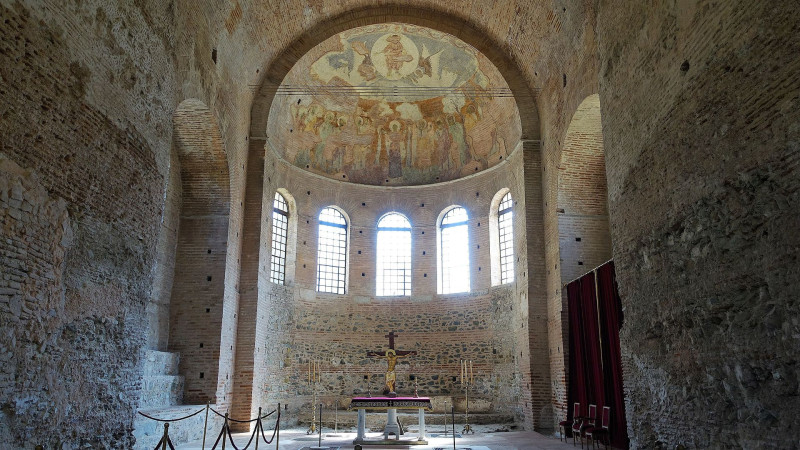The city’s oldest monument hides a special story
By Nicolas Bard
If you have visited Thessaloniki, then you will surely have a walk and have seen Rotonda, which is the city’s oldest monument, along with the neighboring imposing arch, and is one of the most famous landmarks in the city. And not unjustly we would say!
Rotonda is a vaulted 4th -century circular building (304 AD), which is sufficiently attached to Pantheon. Its initial use is not known to us, but various theories have been formulated. Some historians argue that there was a temple of Zeus or the Kavira, and others that it was built by Caesar Galerio as his mausoleum or as a throne hall in the palace complex. The Early Christian period (4th – 7th century AD) was converted into a temple, which today some researchers identify with the temple of the Asomatos forces, which we find in various Byzantine sources. In 1591 he was converted into a mosque by Sheikh Hortaji Suleiman Efendi. After the liberation of Thessaloniki in 1912, it was dedicated to Saint George, and is now included in the list of UNESCO World Heritage Sites.
The imposing rotunda was built in the years of Emperor Galerius around 304 while intended as Mausoleum. However, due to his death in 311, Rotonda was left empty, without any use. At the end of the 4th century, at the time of Theodosius I and after Christianity had prevailed in Thessaloniki, Rotonda was converted into a Christian temple, when some remodels were necessary in the monument, which was necessary for the new worship. Thus, the eastern conch was opened and the addition of the sanctuary, and the corresponding western conch was opened, and a new entrance was created. Still, about eight meters from the wall, another, lower circular wall was built externally, which does not exist today. Finally, the famous mosaics of the monument were created, adorned with arches, arched skylight openings and the big dome. It is considered that the original purpose was to use it as a baptistery of the faithful Christians of Thessaloniki.
From the impressive arch of Galerius a pompous road led to the northeast to Rotonda, the Galerian’s top building Complex, in the imposing, brick, circular in its floor plan. The diameter of the building is 24.5 meters and its height reaches 30 meters. Inside the thickness of the walls, which are 6.30 meters, eight arched niches are opened. Above them there are large windows with arched ends and above, in the meantime, another row of smaller windows. The building is covered with a large hemispherical dome, at the top of which was an OP, to diffuse the sunlight inside. The dome is hidden externally by the elevated perimeter wall, which closes on a wooden tiled roof. The entrance to the monument, in the original construction, was from the southwest, where there is a propylon and there the Pompeii route ended. Outside the southern propylon of the monument has also been found the base of the marble monolithic pulpit, which is currently located in the Museum of Constantinople. Its name is of course due to its circular shape!
The hagiographies that adorn its interior date back to the early 5th century, because the saints depicted all until the time of Diocletian and Maximian. The hagiographies are saved today only under the dome, while the rest were destroyed when the temple became a Muslim mosque by the Turks, and in particular by Sheikh. Suleiman Hortaji Efentis in 1590. Then the minaret was added. The mosaics preserved in the arches and the bows of the skylights are purely decorative. They are depicted in a golden background of geometric shapes in a wide variety, as well as themes from the natural world, such as fruits, animals, birds, canisters and flowers with a naturalistic mood and vibrant colors. At the Tholos, at the top of the great mosaic composition, the Crusader Christ was depicted, depicted in colorful glory, parts of which were preserved today, and was submitted by four angels.
After so many centuries of life, and many useful and architectural changes, Rotonda remains point her town and core Cultural heritage in the sea of apartment buildings that are now flooding the modern center of Thessaloniki. Not only did the monument not erase over time, but remained intact, giving today another air to the city and precisely identifying the great multicultural identity of Thessaloniki, which we hardly encounter.
Source :Skai
I am Frederick Tuttle, who works in 247 News Agency as an author and mostly cover entertainment news. I have worked in this industry for 10 years and have gained a lot of experience. I am a very hard worker and always strive to get the best out of my work. I am also very passionate about my work and always try to keep up with the latest news and trends.











